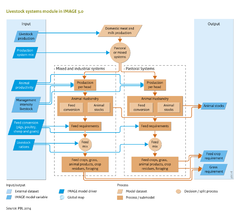Livestock systems: Difference between revisions
Jump to navigation
Jump to search
m (Text replace - "Agricultural systems" to "Land-use allocation") |
Oostenrijr (talk | contribs) No edit summary |
||
| (6 intermediate revisions by 2 users not shown) | |||
| Line 1: | Line 1: | ||
{{ComponentTemplate2 | {{ComponentTemplate2 | ||
|Application=Roads from Rio+20 (2012) project; Global Environmental Outlook - GEO4 (2007) project; Millennium Ecosystem Assessment - MA (2005) project; OECD Environmental Outlook to 2030 (2008) project; OECD Environmental Outlook to 2050 (2012) | |Application=Roads from Rio+20 (2012) project; Global Environmental Outlook - GEO4 (2007) project; Millennium Ecosystem Assessment - MA (2005) project; OECD Environmental Outlook to 2030 (2008) project; OECD Environmental Outlook to 2050 (2012) project; Global Environmental Outlook - GEO3 (2002) project; EU Resource efficiency (2011) project | ||
|IMAGEComponent=Drivers; Agricultural economy; Land-use allocation; Agriculture and land use; Atmospheric composition and climate; | |IMAGEComponent=Drivers; Agricultural economy; Land-use allocation; Agriculture and land use; Atmospheric composition and climate; Crops and grass; | ||
|Model-Database=MAGNET model; | |||
|KeyReference=Bouwman et al., 2005; | |KeyReference=Bouwman et al., 2005; | ||
|Reference=Bruinsma, 2003; Bouwman et al., 2006; Bouwman et al., 2005; Delgado et al., 1999; Seré and Steinfeld, 1996; FAO, 2012a; | |Reference=Bruinsma, 2003; Bouwman et al., 2006; Bouwman et al., 2005; Delgado et al., 1999; Seré and Steinfeld, 1996; FAO, 2012a; | ||
| Line 10: | Line 11: | ||
Interactions between crop and livestock production are described in the livestock systems module of IMAGE, and also the consequences of changing practices in livestock farming for production of food crops and grass. For this purpose, IMAGE distinguishes pastoral livestock systems, and mixed and landless (industrial) production systems. Pastoral systems are based on grazing ruminants, while mixed and landless systems integrate crop and livestock production in which livestock are fed a mix of crops, crop by-products, grass, fodder and crop residues ([[Bouwman et al., 2005]]; [[Bouwman et al., 2006]]). | Interactions between crop and livestock production are described in the livestock systems module of IMAGE, and also the consequences of changing practices in livestock farming for production of food crops and grass. For this purpose, IMAGE distinguishes pastoral livestock systems, and mixed and landless (industrial) production systems. Pastoral systems are based on grazing ruminants, while mixed and landless systems integrate crop and livestock production in which livestock are fed a mix of crops, crop by-products, grass, fodder and crop residues ([[Bouwman et al., 2005]]; [[Bouwman et al., 2006]]). | ||
Livestock production is related to a wide range of the environmental issues, and the consequences of changes in the livestock system can be studied in the IMAGE: | Livestock production is related to a wide range of the environmental issues, and the consequences of changes in the livestock system can be studied in the IMAGE framework: | ||
#Expansion of grazing land and particularly arable land for feed crop production, is required to support increasing livestock numbers. According to Bouwman et al. (2005) most arable land expansion is to increase feed production; | #Expansion of grazing land and particularly arable land for feed crop production, is required to support increasing livestock numbers. According to Bouwman et al. (2005) most arable land expansion is to increase feed production; | ||
#Large amounts of methane ( | #Large amounts of methane (CH<sub>4</sub>) emitted by ruminants during enteric fermentation are the second major source of greenhouse gas emissions after CO2; | ||
#Excreta from all livestock categories is a source of ammonia, methane, nitrous oxide and nitric oxide; | #Excreta from all livestock categories is a source of ammonia, methane, nitrous oxide and nitric oxide; | ||
#Odour nuisance and nitrate leaching to groundwater are major local-scale problems; | #Odour nuisance and nitrate leaching to groundwater are major local-scale problems; | ||
Revision as of 09:28, 22 July 2014
Parts of Livestock systems
| Component is implemented in: |
| Components: |
| Related IMAGE components |
| Projects/Applications |
|
| Models/Databases |
| Key publications |
| References |
Key policy issues
- What are the impacts of increasing livestock production on land use, greenhouse gases and other emissions to air and surface water?
- How does the use of marginal lands for grazing increase the risk of degradation and loss of productivity, inducing more forest clearing?
